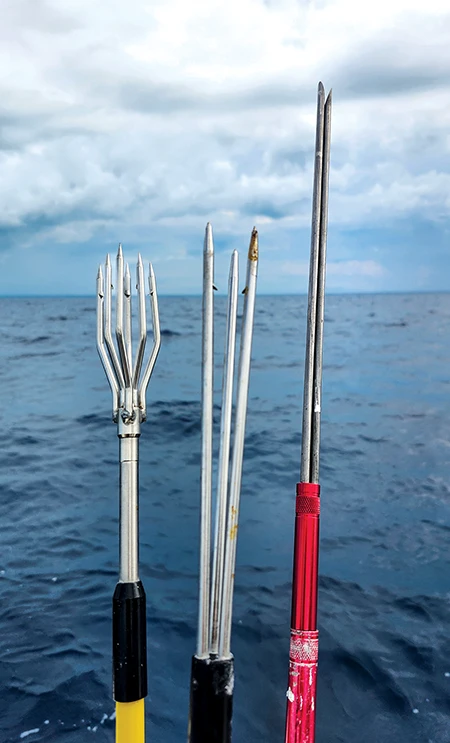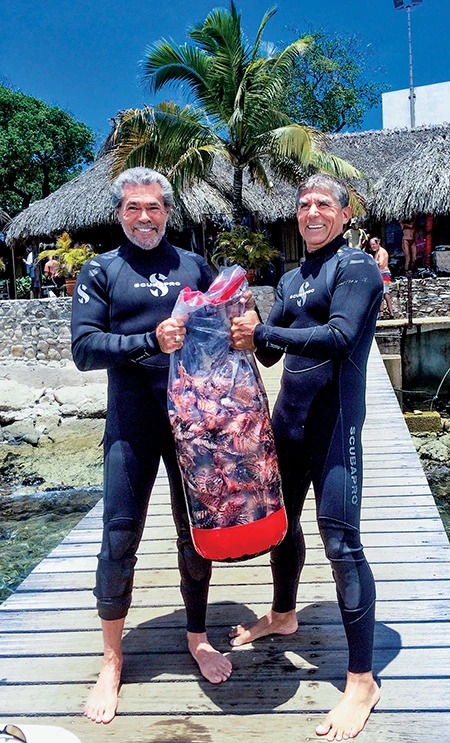Spearing fish has been a part of human sustenance since hunters first sharpened sticks. With the advent of masks and fins, spearfishing became its own activity. Whether for sport or to put food on the table, divers and freedivers seek these opportunities around the world.
While some people are critical of the perceived unfair advantage of being able to select the biggest and most environmentally important individuals, spearfishing recently has become a conservation activity. The invasive lionfish, for example, is native to a broad region of the Indo-Pacific but has become ever-present throughout the Caribbean, Western Atlantic, and the Gulf of Mexico.
In the 15 years since lionfish hunting became prominent, divers have developed numerous tools and techniques to make hunting these invasive predators safe and ecologically beneficial. I’ve witnessed this development while leading dozens of lionfish research projects, removal trips, and derbies.

Lionfish do not belong in the Western Atlantic. Humans introduced them there, and they are now established in a territory without predators, parasites, diseases, or competition to control their population. They are carnivorous predators unlike any other species in this ocean, and studies have documented their significant ecosystem impacts. They grow quickly, can reproduce every few days, and eat anything that moves and fits into their mouths.
Lionfish began appearing in prime dive territory in the Bahamas in 2006 and in Florida a few years later. The first large, organized removal event happened in the summer of 2008 in the waters around Green Turtle Cay in the Bahamas. The event offered prize money for what was called a derby, and divers and snorkelers removed 1,408 lionfish in a single day. Following that success, tools and techniques for removing lionfish began cropping up all over the invaded territory.
Today, most active lionfish hunters carry a small but effective assortment of tools and utilize similar spearing techniques. There are plenty of inexpensive tools and accessories, but some have risen to the top for effectiveness and safety. Let’s dive in and look at what to use and how and where to use it to refine your lionfish hunting skills.


First, you need to know the rules and regulations where you are hunting. Most countries have their own guidelines for spearfishing, and many have developed regulations specific to lionfish. These rules vary widely, so don’t assume that your lionfish hunting license from Roatán means you can freely hunt the same way in Bonaire. Contact the relevant authorities before you plan your lionfish expedition so you will know what rules to follow.
After obtaining your permits and permissions, start gathering your hunting tools. You don’t need a traditional speargun for lionfish. It’s time-consuming to load a spear, manage the line, and secure the bands — that’s a lot of effort for a fish you can approach within a foot or two. Also, once you get a fish, it can slide up and down the spear. That is not an issue with a snapper or grouper, but with a venomous lionfish you’re better off having something that holds the fish securely and far from your hands.
Most avid lionfish hunters prefer a standard 3- or 4-foot (0.9- to 1.2-meter) pole spear, which is basically a stick with a rubber band attached to one end and a tip on the other. The user can hold the spear with a single hand, even with the rubber band under tension. Divers can use their free hand to steady themselves as they slowly approach the lionfish.
Some people like a longer pole spear, specialty spearing device, or Hawaiian sling. Every tool has advantages and disadvantages, but most people, including expert hunters, prefer the standard pole spear. They come in various materials (fiberglass, aluminum, or carbon fiber), thicknesses, and rubber band lengths. There are all kinds of spear tips with three, four, or five tines and different barbs, knurlings, and lengths.
When choosing your preferred style, consider the tip’s footprint, holding power, and how easy it is to remove a speared fish. My favorite setup for most lionfish hunting is a 3-foot (0.9-m) carbon fiber spear with a 1-foot (0.3-m), three-prong spring steel paralyzer tip without barbs. The tip spreads out as it goes into the fish, and the tension between the three prongs holds the fish in place. The lack of barbs makes it easier to remove the fish.
Once you have your spear set up, one of the final considerations is where to stow the fish after you spear them. Some divers leave the lionfish for other marine critters to devour or offer them to predators, hoping they will learn to consume lionfish on their own, but there are better options.
Lionfish are delicious, and there is high demand for them commercially and as subsistence food for locals. You may also be able to have your catch cooked locally. If you are not going to eat the fish, one of the dive crew likely will. Making lionfish a food source is a good use for them that helps lower demand for other fish such as groupers or snappers that are better off staying alive on the reef.

Offering lionfish to other predators is also a safety issue. Feeding sharks, barracudas, and eels — except by professionals in a formal feeding scenario — is asking for trouble. Many people have been bitten by overzealous predators wanting their free meal. Predators will take an easy meal of a speared lionfish but are not likely to attempt devouring a living animal with venomous spines.
Using local knowledge is the best way to find lionfish. Let your guide point them out. If you don’t have a guide, look for the highest relief structures with good overhangs and places for the fish to hide. They are most active in low light but often shelter during prime dive hours.


When preparing to spear a lionfish, pause and think about the best position to prevent damage to the surrounding reef. Unless the fish is accustomed to being harassed, you should be able to get very close with your spear at the ready.
Control your buoyancy and breathing, and steady yourself by carefully placing a finger on a nonliving bottom surface if needed. Aim directly behind the head and above the pectoral fin. If the fish starts to move, let it reposition and then approach again. Chasing the fish or rushing your shot is rarely successful. When the time is right, loosen your grip and let the spear jolt forward.
Lionfish are hardy, and killing one takes a very precise shot. You will likely have a live venomous lionfish on the end of your spear. It is tempting to raise the spear over your head in triumph, but if the fish lurches off the spear and darts for cover, you’ve lost it and may be in the escape path, putting you at risk of getting stung. Pin your fish to the bottom, and work with your buddy to secure it.
If you are going to store your catch, minimize how much you handle it. Hard-sided PVC or plastic containers with a one-way funnel or flap entrance that can strip the fish off your spear are the most common and useful type. The ZooKeeper containment device was invented specifically for safely storing lionfish, and multiple versions of the basic concept are available.
You push the fish into the device, and as you pull out the spear, the fish stays behind. This is where your tip choice comes into play. A claw-style tip with big barbs is great at holding the fish but not so good at letting it go, so think about the tradeoffs between holding and removal if you plan to use a ZooKeeper or similar device. Ensure that the lid and bottom are secure, and keep your fingers and hands away from the openings.
Many hunters have pushed a fish into the storage device and then grabbed the top when pulling out the spear, ending up with the sharp end of a lionfish spine in their hand. Hold the device securely, but keep your hand away from the opening.
A few additional items may help prevent stings or reduce the symptoms if one occurs. Puncture-resistant gloves are invaluable but should meet the American National Standards Institute (ANSI) level-five needlestick (not cut-resistant) rating — this is the highest resistance and can withstand more than 150 newtons of puncture force.

While no one intends to get stung, working near an animal with 18 venomous needle-sharp spines is risky. Slow, thoughtful, deliberate actions reduce the risk, but stings can still happen. Most stings result in pain and swelling at the sting site, and you can reduce those symptoms by immersing the affected area in nonscalding hot water. If you have symptoms beyond isolated pain and swelling or your pain does not respond to hot water, seek medical attention.
When you are out hunting lionfish, remember to protect the reef from damage, be safe, and have fun.
Explore More
Learn more about lionfish hunting in these videos.
© Alert Diver – Q4 2024